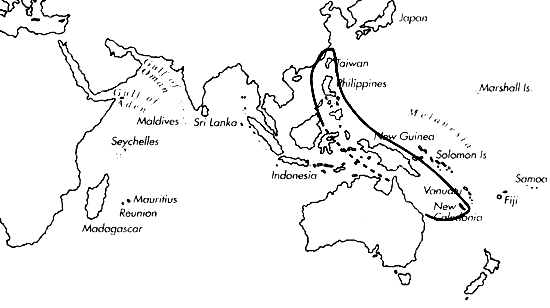Range: Taiwan, Philippines.
Description: Large, solid to heavy. Last whorl conical or ventricosely conical; outline convex adapically, straight (right side) or concave (left side) below. Shoulder subangulate to rounded. Spire of low to moderate height, outline sigmoid, first postnuclear whorls domed. Larval shell of 2-2.5 whorls, maximum diameter 1.1- 1.2 mm. First 5-6 postnuclear whorls tuberculate. Teleoconch sutural ramps flat, with 2 increasing to 7-9 spiral grooves. Last whorl with numerous closely set spiral ribs at base, followed by spiral striae to shoulder.
| Shell Morphometry | ||
|---|---|---|
| L | 98-154 mm | |
| RW | 0.42-1.30 g/mm | |
| (L 98-150 mm) | ||
| RD | 0.51-0.61 | |
| PMD | 0.81-0.88 | |
| RSH | 0.09-0.17 | |
Ground colour white to pale violet. Last whorl with 2 darker violet spiral bands bearing brown axial blotches, on basal third and just above centre; adult specimens also with irregular brown spots and axial streaks. Shoulder edge with brown spots, occasionally also present in preceding whorls. Aperture white to light purple.
Periostracum light brown, thin and translucent to rather thick and opaque.
Habitat and Habits: In 120-400 m.
Discussion: C. tisii most closely resembles C. pergrandis. It differs from the latter in its more conical last whorl (PMD in C. pergrandis 0.77-0.82), generally lower (RSH in C. pergrandis 0.16-0.18) and domed spire, and in its light purple ground colour. The pronounced spiral sculpture on the last whorl of subadult C. pergrandis is absent in subadult C. tisii.

C. tisii range map
This section contains verbatim reproductions of the accounts of 316 species of Conus from the Indo-Pacific region, from Manual of the Living Conidae, by Röckel, Korn and Kohn (1995). They are reproduced with the kind permission of the present publisher, Conchbooks.
All plates and figures referred to in the text are also in Röckel, Korn & Kohn, 1995. Manual of the Living Conidae Vol. 1: Indo-Pacific Region.
The range maps have been modified so that each species account has it own map, rather than one map that showed the ranges of several species in the original work. This was necessary because each species account is on a separate page on the website and not confined to the order of accounts in the book.